一、 Netty简介
1. Netty介绍
Netty 是由 JBOSS 提供的一个 Java 开源框架,现为 Github 上的独立项目。Netty 是一个异步的、基于事件驱动的网络应用框架,用以快速开发高性能、高可靠性的网络 IO 程序。Netty 主要针对在 TCP 协议下,面向 Client 端的高并发应用,或者 Peer-to-Peer 场景下的大量数据持续传输的应用。Netty 本质是一个 NIO 框架,适用于服务器通讯相关的多种应用场景。- 要透彻理解
Netty,需要先学习 NIO,这样我们才能阅读 Netty 的源码。
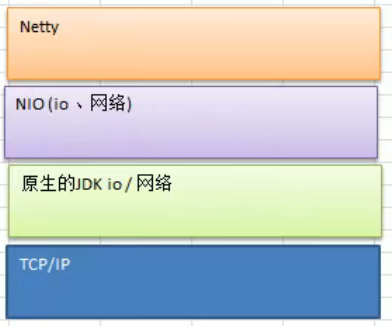
2. Netty的应用场景
互联网行业
- 互联网行业:在分布式系统中,各个节点之间需要远程服务调用,高性能的
RPC 框架必不可少,Netty 作为异步高性能的通信框架,往往作为基础通信组件被这些 RPC 框架使用。
- 典型的应用有:阿里分布式服务框架
Dubbo 的 RPC 框 架使用 Dubbo 协议进行节点间通信,Dubbo 协议默认使用 Netty 作为基础通信组件,用于实现各进程节点之间的内部通信。
游戏行业
- 游戏行业 协议栈,方便定制和开发私有协议栈,账号登录服务器。
Netty 作为高性能的基础通信组件,提供了 TCP/UDP 和 HTTP 协议栈,方便定制和开发私有协议栈,账号登录服务器。- 地图服务器之间可以方便的通过
Netty 进行高性能的通信。
大数据领域
- 经典的
Hadoop 的高性能通信和序列化组件 Avro 的 RPC 框架,默认采用 Netty 进行跨界点通信。
- 它的
NettyService 基于 Netty 框架二次封装实现。
大数据行业
- 经典的
Hadoop 的高性能通信和序列化组件 Avro 的 RPC 框架,默认采用 Netty 进行跨界点通信。
- 它的
NettyService 基于 Netty 框架二次封装实现。
二、Java BIO编程
1. I/O模型
I/O 模型简单的理解:就是用什么样的通道进行数据的发送和接收,很大程度上决定了程序通信的性能。
Java 共支持 3 种网络编程模型 I/O 模式:BIO、NIO、AIO。
Java BIO:同步并阻塞(传统阻塞型),服务器实现模式为一个连接一个线程,即客户端有连接请求时服务器端就需要启动一个线程进行处理,如果这个连接不做任何事情会造成不必要的线程开销。【简单示意图】
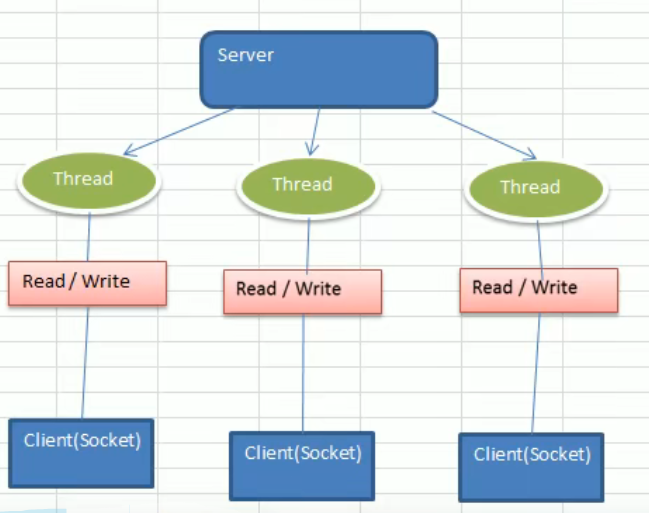
Java NIO:同步非阻塞,服务器实现模式为一个线程处理多个请求(连接),即客户端发送的连接请求都会注册到多路复用器上,多路复用器轮询到连接有 I/O 请求就进行处理。【简单示意图】

Java AIO(NIO.2):异步非阻塞,AIO 引入异步通道的概念,采用了 Proactor 模式,简化了程序编写,有效的请求才启动线程,它的特点是先由操作系统完成后才通知服务端程序启动线程去处理,一般适用于连接数较多且连接时间较长的应用。
2. BIO、NIO、AIO使用场景分析
BIO 方式适用于连接数目比较小且固定的架构,这种方式对服务器资源要求比较高,并发局限于应用中,JDK1.4 以前的唯一选择,但程序简单易理解。NIO 方式适用于连接数目多且连接比较短(轻操作)的架构,比如聊天服务器,弹幕系统,服务器间通讯等。编程比较复杂,JDK1.4 开始支持。AIO 方式使用于连接数目多且连接比较长(重操作)的架构,比如相册服务器,充分调用 OS 参与并发操作,编程比较复杂,JDK7 开始支持。
3. Java BIO基本介绍
Java BIO 就是传统的 Java I/O 编程,其相关的类和接口在 java.io。BIO(BlockingI/O):同步阻塞,服务器实现模式为一个连接一个线程,即客户端有连接请求时服务器端就需要启动一个线程进行处理,如果这个连接不做任何事情会造成不必要的线程开销,可以通过线程池机制改善(实现多个客户连接服务器)。【后有应用实例】BIO 方式适用于连接数目比较小且固定的架构,这种方式对服务器资源要求比较高,并发局限于应用中,JDK1.4 以前的唯一选择,程序简单易理解。
4. Java BIO工作机制
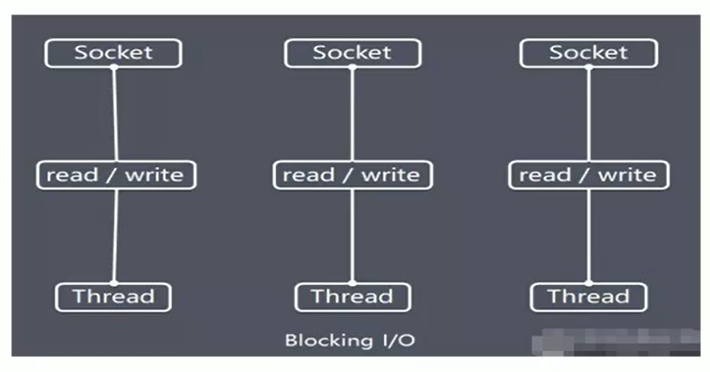
对 BIO 编程流程的梳理
- 服务器端启动一个
ServerSocket。
- 客户端启动
Socket 对服务器进行通信,默认情况下服务器端需要对每个客户建立一个线程与之通讯。
- 客户端发出请求后,先咨询服务器是否有线程响应,如果没有则会等待,或者被拒绝。
- 如果有响应,客户端线程会等待请求结束后,再继续执行。
5. Java BIO应用实例
实例说明:
- 使用
BIO 模型编写一个服务器端,监听 6666 端口,当有客户端连接时,就启动一个线程与之通讯。
- 要求使用线程池机制改善,可以连接多个客户端。
- 服务器端可以接收客户端发送的数据(
telnet 方式即可)。
- 代码演示:
1
2
3
4
5
6
7
8
9
10
11
12
13
14
15
16
17
18
19
20
21
22
23
24
25
26
27
28
29
30
31
32
33
34
35
36
37
38
39
40
41
42
43
44
45
46
47
48
49
50
51
52
53
54
55
56
57
58
59
60
61
62
63
64
65
66
67
68
69
70
71
72
73
74
75
76
77
78
79
80
81
82
83
84
| package com.fyp.bio;
import java.io.IOException;
import java.io.InputStream;
import java.net.ServerSocket;
import java.net.Socket;
import java.util.concurrent.ExecutorService;
import java.util.concurrent.Executors;
public class BIOServer {
public static void main(String[] args) throws IOException {
ExecutorService newCachedThreadPool = Executors.newCachedThreadPool();
ServerSocket serverSocket = new ServerSocket(6666);
System.out.println("服务器启动了");
while (true) {
System.out.println("等待连接");
final Socket socket = serverSocket.accept();
System.out.println("连接到一个客户端");
newCachedThreadPool.execute(new Runnable() {
@Override
public void run() {
handler(socket);
}
});
}
}
public static void handler(Socket socket) {
try {
System.out.println("线程信息 id = " + Thread.currentThread().getId() + " 名字 = " + Thread.currentThread().getName());
byte[] bytes = new byte[10];
InputStream inputStream = socket.getInputStream();
while (true) {
System.out.println("read....");
int read = inputStream.read(bytes);
if(read != -1) {
System.out.println("线程信息 id = " + Thread.currentThread().getId() + " 名字 = " + Thread.currentThread().getName() + " -- " + new String(bytes, 0, read));
} else {
System.out.println("break");
break;
}
}
System.out.println("跳出read循环");
} catch (IOException e) {
e.printStackTrace();
} finally {
System.out.println("关闭和client的连接");
try {
socket.close();
} catch (Exception e) {
e.printStackTrace();
}
}
}
}
|
6. 总结
- 每个请求都需要创建独立的线程,与对应的客户端进行数据
Read,业务处理,数据 Write。
- 当并发数较大时,需要创建大量线程来处理连接,系统资源占用较大。
- 连接建立后,如果当前线程暂时没有数据可读,则线程就阻塞在
Read 操作上,造成线程资源浪费。
三、Java NIO编程
1. Java NIO基本介绍
Java NIO 全称 Java non-blocking IO,是指 JDK 提供的新 API。从 JDK1.4 开始,Java 提供了一系列改进的输入/输出的新特性,被统称为 NIO(即 NewIO),是同步非阻塞的。NIO 相关类都被放在 java.nio 包及子包下,并且对原 java.io 包中的很多类进行改写。【基本案例】NIO 有三大核心部分:**Channel(通道)、Buffer(缓冲区)、Selector(选择器)** 。NIO 是面向缓冲区,或者面向块编程的。数据读取到一个它稍后处理的缓冲区,需要时可在缓冲区中前后移动,这就增加了处理过程中的灵活性,使用它可以提供非阻塞式的高伸缩性网络。Java NIO 的非阻塞模式,使一个线程从某通道发送请求或者读取数据,但是它仅能得到目前可用的数据,如果目前没有数据可用时,就什么都不会获取,而不是保持线程阻塞,所以直至数据变的可以读取之前,该线程可以继续做其他的事情。非阻塞写也是如此,一个线程请求写入一些数据到某通道,但不需要等待它完全写入,这个线程同时可以去做别的事情。【后面有案例说明】- 通俗理解:
NIO 是可以做到用一个线程来处理多个操作的。假设有 10000 个请求过来,根据实际情况,可以分配 50 或者 100 个线程来处理。不像之前的阻塞 IO 那样,非得分配 10000 个。
HTTP 2.0 使用了多路复用的技术,做到同一个连接并发处理多个请求,而且并发请求的数量比 HTTP 1.1 大了好几个数量级。
2. NIO和BIO的比较
BIO 以流的方式处理数据,而 NIO 以块的方式处理数据,块 I/O 的效率比流 I/O 高很多。
BIO 是阻塞的,NIO 则是非阻塞的。
BIO 基于字节流和字符流进行操作,而 NIO 基于 Channel(通道)和 Buffer(缓冲区)进行操作,数据总是从通道读取到缓冲区中,或者从缓冲区写入到通道中。Selector(选择器)用于监听多个通道的事件(比如:连接请求,数据到达等),因此使用单个线程就可以监听多个客户端通道。
Buffer和Channel之间的数据流向是双向的
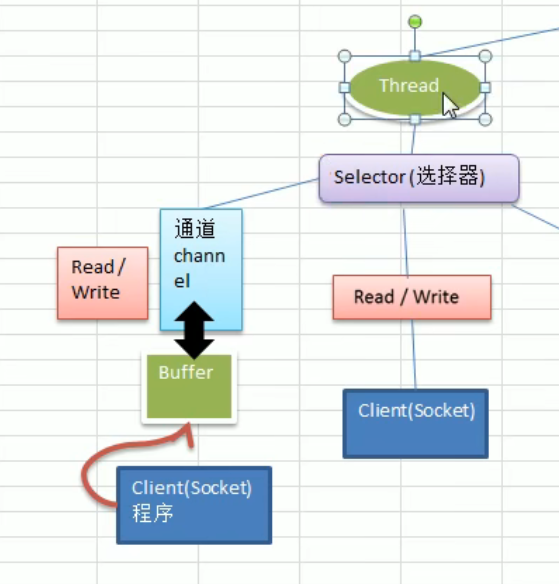
3. NIO三大核心原理示意图
一张图描述 NIO 的 Selector、Channel 和 Buffer 的关系。
Selector、Channel 和 Buffer 关系图(简单版)
关系图的说明:
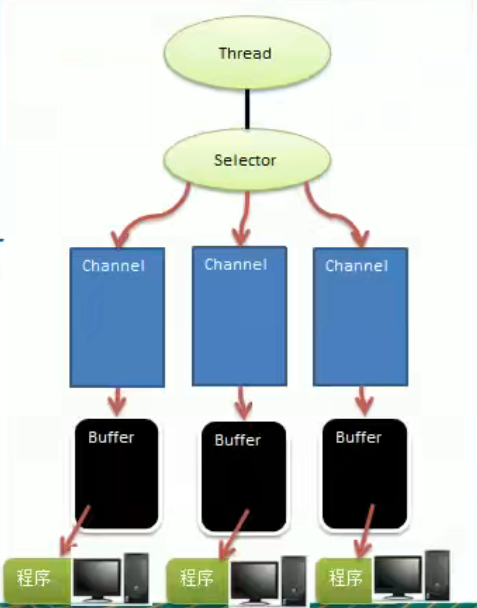
- 每个
Channel 都会对应一个 Buffer。
Selector 对应一个线程,一个线程对应多个 Channel(连接)。- 该图反应了有三个
Channel 注册到该 Selector //程序
- 程序切换到哪个
Channel 是由事件决定的,Event 就是一个重要的概念。
Selector 会根据不同的事件,在各个通道上切换。Buffer 就是一个内存块,底层是有一个数组。- 数据的读取写入是通过
Buffer,这个和 BIO是不同的,BIO 中要么是输入流,或者是输出流,不能双向,但是 NIO 的 Buffer 是可以读也可以写,需要 flip 方法切换 Channel 是双向的,可以返回底层操作系统的情况,比如 Linux,底层的操作系统通道就是双向的。
4. 缓冲区(Buffer)
缓冲区(Buffer):缓冲区本质上是一个可以读写数据的内存块,可以理解成是一个容器对象(含数组),该对象提供了一组方法,可以更轻松地使用内存块,缓冲区对象内置了一些机制,能够跟踪和记录缓冲区的状态变化情况。Channel 提供从文件、网络读取数据的渠道,但是读取或写入的数据都必须经由 Buffer,如图:【后面举例说明】

Buffer 类及其子类
在 NIO 中,Buffer 是一个顶层父类,它是一个抽象类,类的层级关系图
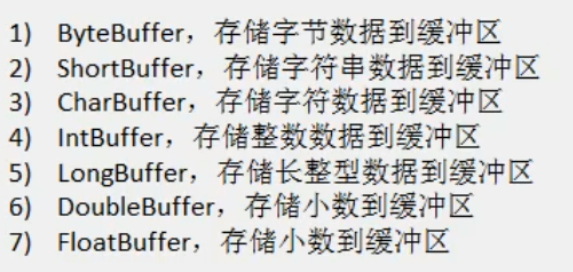
Buffer 类定义了所有的缓冲区都具有的四个属性来提供关于其所包含的数据元素的信息:

Buffer 类相关方法一览
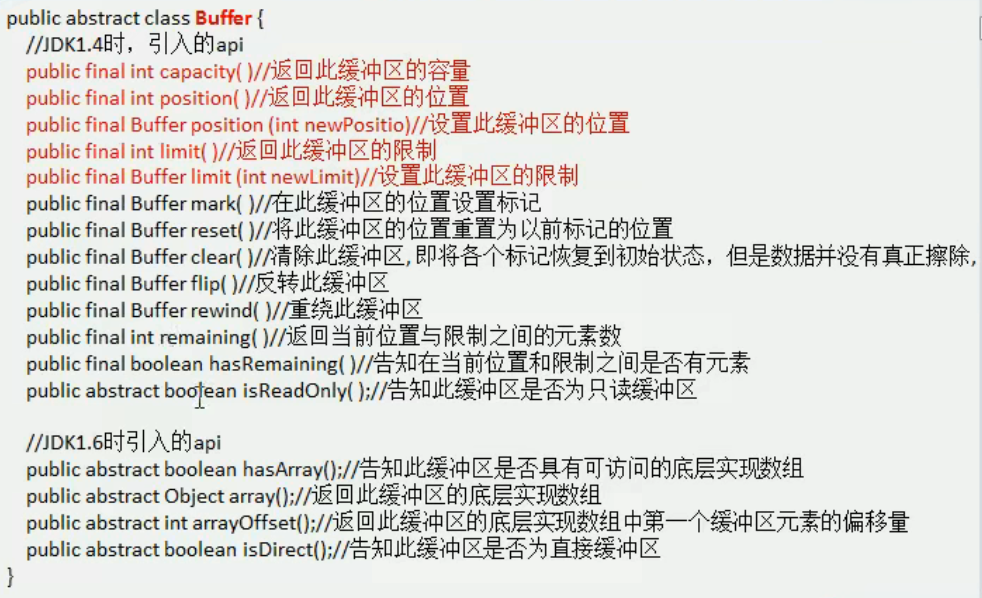
ByteBuffer
从前面可以看出对于 Java 中的基本数据类型(boolean 除外),都有一个 Buffer 类型与之相对应,最常用的自然是 ByteBuffer 类(二进制数据),该类的主要方法如下:
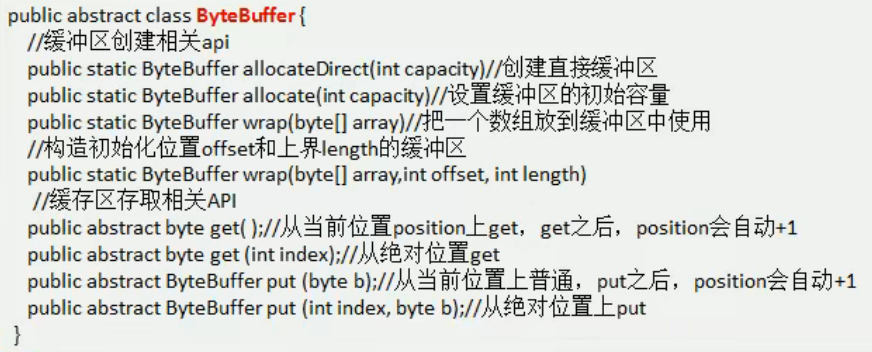
5. 通道(Channel)
基本介绍
NIO的通道类似于流,但有些区别如下:
- 通道可以同时进行读写,而流只能读或者只能写
- 通道可以实现异步读写数据
- 通道可以从缓冲读数据,也可以写数据到缓冲:
BIO 中的 Stream 是单向的,例如 FileInputStream 对象只能进行读取数据的操作,而 NIO 中的通道(Channel)是双向的,可以读操作,也可以写操作。
Channel 在 NIO 中是一个接口 public interface Channel extends Closeable{}
常用的 Channel 类有:**FileChannel、DatagramChannel、ServerSocketChannel 和 SocketChannel**。【ServerSocketChanne 类似 ServerSocket、SocketChannel 类似 Socket】
FileChannel 用于文件的数据读写,DatagramChannel 用于 UDP 的数据读写,ServerSocketChannel 和 SocketChannel 用于 TCP 的数据读写。
图示
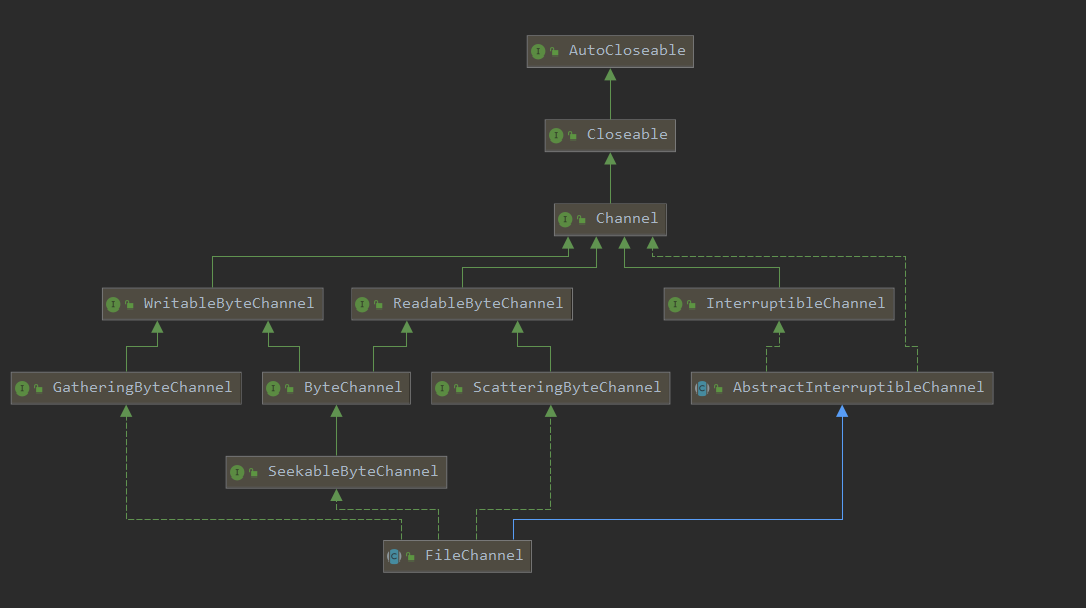
FileChannel 类
FileChannel 主要用来对本地文件进行 IO 操作,常见的方法有
public int read(ByteBuffer dst),从通道读取数据并放到缓冲区中public int write(ByteBuffer src),把缓冲区的数据写到通道中public long transferFrom(ReadableByteChannel src, long position, long count),从目标通道中复制数据到当前通道public long transferTo(long position, long count, WritableByteChannel target),把数据从当前通道复制给目标通道
应用实例1 - 本地文件写数据
实例要求:
- 使用前面学习后的
ByteBuffer(缓冲)和 FileChannel(通道),将 “hello,尚硅谷” 写入到 file01.txt 中
- 文件不存在就创建
- 代码演示
1
2
3
4
5
6
7
8
9
10
11
12
13
14
15
16
17
18
19
20
21
22
23
24
25
26
27
28
29
30
31
32
33
34
35
36
37
38
39
40
41
42
| package com.fyp.nio;
import sun.nio.ByteBuffered;
import java.io.FileOutputStream;
import java.io.IOException;
import java.nio.ByteBuffer;
import java.nio.channels.FileChannel;
public class NIOFileChannel01 {
public static void main(String[] args) throws IOException {
String str = "hello,尚硅谷";
FileOutputStream fileOutputStream = new FileOutputStream("d:\\file01.txt");
FileChannel fileChannel = fileOutputStream.getChannel();
ByteBuffer byteBuffer = ByteBuffer.allocate(1024);
byteBuffer.put(str.getBytes());
byteBuffer.flip();
fileChannel.write(byteBuffer);
fileOutputStream.close();
}
}
|
应用实例2 - 本地文件读数据
实例要求:
- 使用前面学习后的
ByteBuffer(缓冲)和 FileChannel(通道),将 file01.txt 中的数据读入到程序,并显示在控制台屏幕
- 假定文件已经存在
- 代码演示
1
2
3
4
5
6
7
8
9
10
11
12
13
14
15
16
17
18
19
20
21
22
23
24
25
26
27
28
29
30
31
32
33
34
35
36
37
| package com.fyp.nio;
import com.sun.xml.internal.fastinfoset.stax.events.AttributeBase;
import java.io.*;
import java.nio.ByteBuffer;
import java.nio.channels.FileChannel;
public class NIOFileChannel02 {
public static void main(String[] args) throws IOException {
File file = new File("d:\\file01.txt");
FileInputStream fileInputStream = new FileInputStream(file);
FileChannel fileChannel = fileInputStream.getChannel();
ByteBuffer byteBuffer = ByteBuffer.allocate((int) file.length());
fileChannel.read(byteBuffer);
System.out.println(new String(byteBuffer.array()));
fileInputStream.close();
}
}
|
应用实例3 - 使用一个 Buffer 完成文件读取、写入
实例要求:
- 使用
FileChannel(通道)和方法 read、write,完成文件的拷贝
- 拷贝一个文本文件
1.txt,放在项目下即可
- 代码演示

1
2
3
4
5
6
7
8
9
10
11
12
13
14
15
16
17
18
19
20
21
22
23
24
25
26
27
28
29
30
31
32
33
34
35
36
37
38
39
40
41
42
43
44
45
46
47
48
49
50
51
52
| package com.fyp.nio;
import java.io.FileInputStream;
import java.io.FileNotFoundException;
import java.io.FileOutputStream;
import java.io.IOException;
import java.nio.ByteBuffer;
import java.nio.channels.FileChannel;
public class NIOFileChannel03 {
public static void main(String[] args) throws IOException {
FileInputStream fileInputStream = new FileInputStream("1.txt");
FileChannel fileChannel01 = fileInputStream.getChannel();
FileOutputStream fileOutputStream = new FileOutputStream("2.txt");
FileChannel fileChannel02 = fileOutputStream.getChannel();
ByteBuffer byteBuffer = ByteBuffer.allocate(512);
while (true) {
byteBuffer.clear();
int read = fileChannel01.read(byteBuffer);
System.out.println("read= " + read);
if (read == -1) {
break;
}
byteBuffer.flip();
fileChannel02.write(byteBuffer);
}
fileInputStream.close();
}
}
|
应用实例4 - 拷贝文件 transferFrom 方法
- 实例要求:
- 使用
FileChannel(通道)和方法 transferFrom,完成文件的拷贝
- 拷贝一张图片
- 代码演示
1
2
3
4
5
6
7
8
9
10
11
12
13
14
15
16
17
18
19
20
21
22
23
24
25
26
27
28
29
30
31
32
33
34
| package com.fyp.nio;
import java.io.FileInputStream;
import java.io.FileOutputStream;
import java.io.IOException;
import java.nio.channels.FileChannel;
public class NIOFileChannel04 {
public static void main(String[] args) throws IOException {
FileInputStream fileInputStream = new FileInputStream("d:\\wallhaven.png");
FileOutputStream fileOutputStream = new FileOutputStream("d:\\wallhaven01.png");
FileChannel sourceCh = fileInputStream.getChannel();
FileChannel destCh = fileOutputStream.getChannel();
destCh.transferFrom(sourceCh, 0, sourceCh.size());
sourceCh.close();
destCh.close();
fileInputStream.close();
fileOutputStream.close();
}
}
|
关于 Buffer 和 Channel 的注意事项和细节
ByteBuffer 支持类型化的 put 和 get,put 放入的是什么数据类型,get 就应该使用相应的数据类型来取出,否则可能有 BufferUnderflowException 异常。【举例说明】
1
2
3
4
5
6
7
8
9
10
11
12
13
14
15
16
17
18
19
20
21
22
23
24
25
26
27
28
29
30
31
32
33
34
35
36
37
| package com.fyp.nio;
import java.nio.Buffer;
import java.nio.ByteBuffer;
public class NIOByteBufferPutGet {
public static void main(String[] args) {
ByteBuffer byteBuffer = ByteBuffer.allocate(64);
byteBuffer.putInt(100);
byteBuffer.putLong(9);
byteBuffer.putChar('尚');
byteBuffer.putShort((short) 4);
byteBuffer.flip();
System.out.println();
System.out.println(byteBuffer.getInt());
System.out.println(byteBuffer.getLong());
System.out.println(byteBuffer.getChar());
System.out.println(byteBuffer.getShort());
}
}
|
- 可以将一个普通
Buffer 转成只读 Buffer【举例说明】
1
2
3
4
5
6
7
8
9
10
11
12
13
14
15
16
17
18
19
20
21
22
23
24
25
26
27
28
29
30
31
32
33
34
35
36
37
38
| package com.fyp.nio;
import java.nio.Buffer;
import java.nio.ByteBuffer;
public class ReadOnlyBuffer {
public static void main(String[] args) {
ByteBuffer byteBuffer = ByteBuffer.allocate(64);
for (int i = 0; i < 64; i++) {
byteBuffer.put((byte) i);
}
byteBuffer.flip();
ByteBuffer readOnlyBuffer = byteBuffer.asReadOnlyBuffer();
System.out.println(readOnlyBuffer.getClass());
while (readOnlyBuffer.hasRemaining()) {
System.out.println(readOnlyBuffer.get());
}
}
}
|
NIO 还提供了 MappedByteBuffer,可以让文件直接在内存(堆外的内存)中进行修改,而如何同步到文件由 NIO 来完成。【举例说明】
1
2
3
4
5
6
7
8
9
10
11
12
13
14
15
16
17
18
19
20
21
22
23
24
25
26
27
28
29
30
31
32
33
34
35
36
37
38
39
40
41
| package com.fyp.nio;
import java.io.RandomAccessFile;
import java.nio.MappedByteBuffer;
import java.nio.channels.FileChannel;
public class MappedByteBufferTest {
public static void main(String[] args) throws Exception {
RandomAccessFile randomAccessFile = new RandomAccessFile("1.txt", "rw");
FileChannel channel = randomAccessFile.getChannel();
MappedByteBuffer mappedByteBuffer = channel.map(FileChannel.MapMode.READ_WRITE, 0, 5);
mappedByteBuffer.put(0, (byte) 'H');
mappedByteBuffer.put(3, (byte) '9');
randomAccessFile.close();
}
}
|
- 前面我们讲的读写操作,都是通过一个
Buffer 完成的,NIO 还支持通过多个 Buffer(即 Buffer数组)完成读写操作,即 Scattering 和 Gathering【举例说明】
1
2
3
4
5
6
7
8
9
10
11
12
13
14
15
16
17
18
19
20
21
22
23
24
25
26
27
28
29
30
31
32
33
34
35
36
37
38
39
40
41
42
43
44
45
46
47
48
49
50
51
52
53
54
55
56
57
58
59
60
61
62
63
64
65
66
67
68
69
70
| package com.fyp.nio;
import java.net.InetSocketAddress;
import java.nio.ByteBuffer;
import java.nio.channels.ServerSocketChannel;
import java.nio.channels.SocketChannel;
import java.util.Arrays;
public class ScatteringAndGatheringTest {
public static void main(String[] args) throws Exception{
ServerSocketChannel serverSocketChannel = ServerSocketChannel.open();
InetSocketAddress inetSocketAddress = new InetSocketAddress(7000);
serverSocketChannel.socket().bind(inetSocketAddress);
ByteBuffer[] byteBuffers = new ByteBuffer[2];
byteBuffers[0] = ByteBuffer.allocate(5);
byteBuffers[1] = ByteBuffer.allocate(3);
SocketChannel socketChannel = serverSocketChannel.accept();
int messageLength = 8;
while (true) {
int byteRead = 0;
while (byteRead < messageLength) {
long l = socketChannel.read(byteBuffers);
byteRead += l;
System.out.println("byteRead= " + byteRead);
Arrays.asList(byteBuffers).stream().map(buffer -> "position= " +
buffer.position() + ",limit= " + buffer.limit()).forEach(System.out::println);
}
Arrays.asList(byteBuffers).forEach(buffer -> buffer.flip());
long byteWrite = 0;
while (byteWrite < messageLength) {
long l = socketChannel.write(byteBuffers);
byteWrite += 1;
}
Arrays.asList(byteBuffers).forEach(buffer -> {
buffer.clear();
});
System.out.println("byteRead= " + byteRead + ",byteWrite= " + byteWrite + ",messageLength= " + messageLength);
}
}
}
|
6. 选择器(Selector)
基本介绍
Java 的 NIO,用非阻塞的 IO 方式。可以用一个线程,处理多个的客户端连接,就会使用到 Selector(选择器)。Selector 能够检测多个注册的通道上是否有事件发生(注意:多个 Channel 以事件的方式可以注册到同一个 Selector),如果有事件发生,便获取事件然后针对每个事件进行相应的处理。这样就可以只用一个单线程去管理多个通道,也就是管理多个连接和请求。- 只有在连接/通道真正有读写事件发生时,才会进行读写,就大大地减少了系统开销,并且不必为每个连接都创建一个线程,不用去维护多个线程。
- 避免了多线程之间的上下文切换导致的开销。
Selector 示意图和特点说明
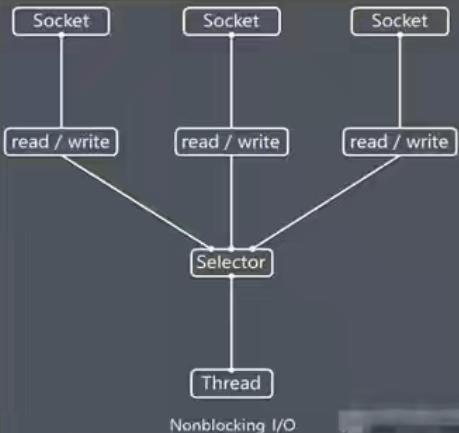
说明如下:
Netty 的 IO 线程 NioEventLoop 聚合了 Selector(选择器,也叫多路复用器),可以同时并发处理成百上千个客户端连接。- 当线程从某客户端
Socket 通道进行读写数据时,若没有数据可用时,该线程可以进行其他任务。
- 线程通常将非阻塞
IO 的空闲时间用于在其他通道上执行 IO 操作,所以单独的线程可以管理多个输入和输出通道。
- 由于读写操作都是非阻塞的,这就可以充分提升
IO 线程的运行效率,避免由于频繁 I/O 阻塞导致的线程挂起。
- 一个
I/O 线程可以并发处理 N 个客户端连接和读写操作,这从根本上解决了传统同步阻塞 I/O 一连接一线程模型,架构的性能、弹性伸缩能力和可靠性都得到了极大的提升。
Selector 类相关方法

注意事项
NIO 中的 ServerSocketChannel 功能类似 ServerSocket、SocketChannel 功能类似 Socket。Selector相关方法说明
selector.select(); //阻塞selector.select(1000); //阻塞 1000 毫秒,在 1000 毫秒后返回selector.wakeup(); //唤醒 selectorselector.selectNow(); //不阻塞,立马返还
7. NIO非阻塞网络编程原理分析图
NIO 非阻塞网络编程相关的(Selector、SelectionKey、ServerScoketChannel 和 SocketChannel)关系梳理图
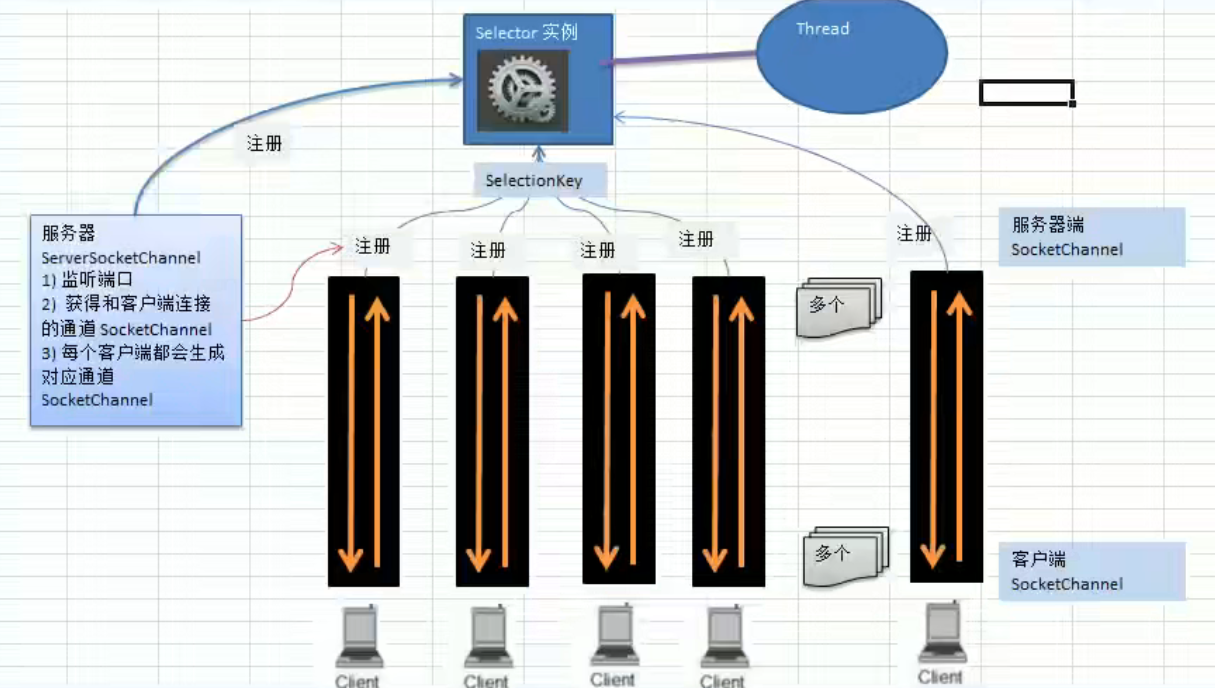
对上图的说明:
- 当客户端连接时,会通过
ServerSocketChannel 得到 SocketChannel。
Selector 进行监听 select 方法,返回有事件发生的通道的个数。- 将
socketChannel 注册到 Selector 上,register(Selector sel, int ops),一个 Selector 上可以注册多个 SocketChannel。
- 注册后返回一个
SelectionKey,会和该 Selector 关联(集合)。
- 进一步得到各个
SelectionKey(有事件发生)。
- 在通过
SelectionKey 反向获取 SocketChannel,方法 channel()。
- 可以通过得到的
channel,完成业务处理。
- 直接看后面代码吧
8. NIO非阻塞网络编程快速入门
案例:
- 编写一个
NIO 入门案例,实现服务器端和客户端之间的数据简单通讯(非阻塞)
- 目的:理解
NIO 非阻塞网络编程机制
服务端:
1
2
3
4
5
6
7
8
9
10
11
12
13
14
15
16
17
18
19
20
21
22
23
24
25
26
27
28
29
30
31
32
33
34
35
36
37
38
39
40
41
42
43
44
45
46
47
48
49
50
51
52
53
54
55
56
57
58
59
60
61
62
63
64
65
66
67
68
69
70
71
72
73
74
75
76
77
78
79
| package com.fyp.nio;
import java.io.IOException;
import java.net.InetSocketAddress;
import java.nio.ByteBuffer;
import java.nio.channels.*;
import java.util.Iterator;
import java.util.Set;
public class NIOServer {
public static void main(String[] args) throws IOException {
ServerSocketChannel serverSocketChannel = ServerSocketChannel.open();
Selector selector = Selector.open();
serverSocketChannel.socket().bind(new InetSocketAddress(6666));
serverSocketChannel.configureBlocking(false);
serverSocketChannel.register(selector, SelectionKey.OP_ACCEPT);
while (true) {
if (selector.select(1000) == 0) {
System.out.println("服务器等待了1秒,无连接");
continue;
}
Set<SelectionKey> selectionKeys = selector.selectedKeys();
Iterator<SelectionKey> keyIterator = selectionKeys.iterator();
while (keyIterator.hasNext()) {
SelectionKey key = keyIterator.next();
if (key.isAcceptable()) {
SocketChannel socketChannel = serverSocketChannel.accept();
System.out.println("客户端连接成功!生成了一个socketChannel " + socketChannel.hashCode());
socketChannel.configureBlocking(false);
socketChannel.register(selector, SelectionKey.OP_READ, ByteBuffer.allocate(1024));
}
if (key.isReadable()) {
SocketChannel channel = (SocketChannel) key.channel();
ByteBuffer buffer = (ByteBuffer) key.attachment();
channel.read(buffer);
System.out.println("from 客户端: " + new String(buffer.array()));
}
keyIterator.remove();
}
}
}
}
|
客户端:
1
2
3
4
5
6
7
8
9
10
11
12
13
14
15
16
17
18
19
20
21
22
23
24
25
26
27
28
29
30
31
32
33
34
35
36
37
38
39
40
41
42
| package com.fyp.nio;
import java.io.IOException;
import java.net.InetSocketAddress;
import java.nio.ByteBuffer;
import java.nio.channels.SocketChannel;
public class NIOClient {
public static void main(String[] args) throws IOException {
SocketChannel socketChannel = SocketChannel.open();
socketChannel.configureBlocking(false);
InetSocketAddress inetSocketAddress = new InetSocketAddress("127.0.0.1", 6666);
if (!socketChannel.connect(inetSocketAddress)) {
while (!socketChannel.finishConnect()) {
System.out.println("因为连接需要时间,客户端不会阻塞,可以做其他工作");
}
}
String str = "hello, 尚硅谷";
ByteBuffer buffer = ByteBuffer.wrap(str.getBytes());
socketChannel.write(buffer);
System.in.read();
}
}
|
SelectionKey
SelectionKey,表示Selector和网络通道的注册关系,共四种:
int OP_ACCEPT:有新的网络连接可以 accept,值为 16int OP_CONNECT:代表连接已经建立,值为 8int OP_READ:代表读操作,值为 1int OP_WRITE:代表写操作,值为 4
源码中:
1
2
3
4
| public static final int OP_READ = 1 << 0;
public static final int OP_WRITE = 1 << 2;
public static final int OP_CONNECT = 1 << 3;
public static final int OP_ACCEPT = 1 << 4;
|
SelectionKey 相关方法
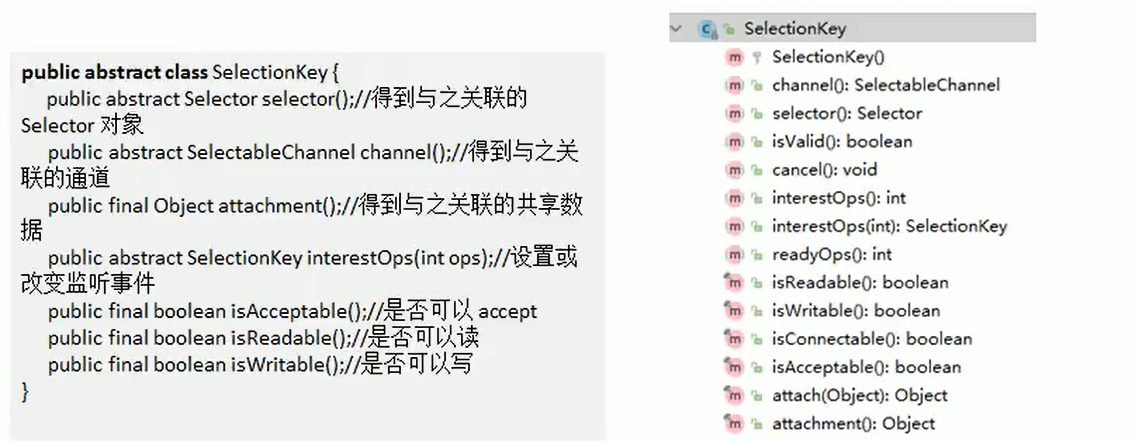
ServerSocketChannel
ServerSocketChannel 在服务器端监听新的客户端 Socket 连接,负责监听,不负责实际的读写操作- 相关方法如下

SocketChannel
SocketChannel,网络 IO 通道,具体负责进行读写操作。NIO 把缓冲区的数据写入通道,或者把通道里的数据读到缓冲区。- 相关方法如下
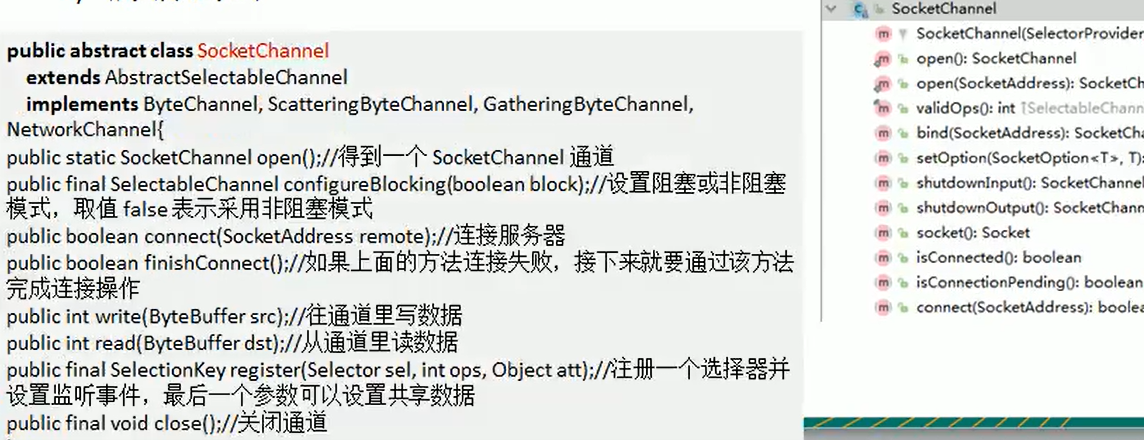
9. NIO网络编程应用实例-群聊系统
实例要求:
- 编写一个
NIO 群聊系统,实现服务器端和客户端之间的数据简单通讯(非阻塞)
- 实现多人群聊
- 服务器端:可以监测用户上线,离线,并实现消息转发功能
- 客户端:通过
Channel 可以无阻塞发送消息给其它所有用户,同时可以接受其它用户发送的消息(由服务器转发得到)
- 目的:进一步理解
NIO 非阻塞网络编程机制
- 示意图分析和代码
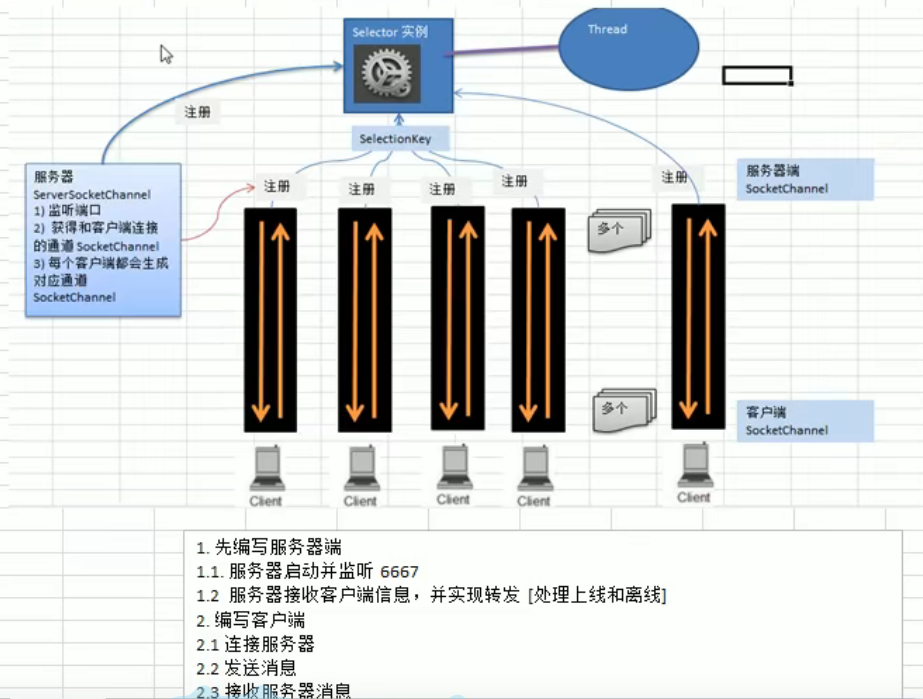
服务端:
1
2
3
4
5
6
7
8
9
10
11
12
13
14
15
16
17
18
19
20
21
22
23
24
25
26
27
28
29
30
31
32
33
34
35
36
37
38
39
40
41
42
43
44
45
46
47
48
49
50
51
52
53
54
55
56
57
58
59
60
61
62
63
64
65
66
67
68
69
70
71
72
73
74
75
76
77
78
79
80
81
82
83
84
85
86
87
88
89
90
91
92
93
94
95
96
97
98
99
100
101
102
103
104
105
106
107
108
109
110
111
112
113
114
115
116
117
118
119
120
121
122
123
124
125
126
127
128
129
130
131
132
133
134
135
136
137
138
139
140
141
142
143
144
145
146
147
148
149
150
151
152
| package com.fyp.nio.groupchat;
import java.io.IOException;
import java.net.InetSocketAddress;
import java.net.Socket;
import java.nio.ByteBuffer;
import java.nio.channels.*;
import java.util.Iterator;
public class GroupChatServer {
private Selector selector;
private ServerSocketChannel listenChannel;
private static final int PORT = 6667;
public GroupChatServer() {
try {
selector = Selector.open();
listenChannel = ServerSocketChannel.open();
listenChannel.socket().bind(new InetSocketAddress(PORT));
listenChannel.configureBlocking(false);
listenChannel.register(selector, SelectionKey.OP_ACCEPT);
} catch (IOException e) {
e.printStackTrace();
}
}
public void listen() {
try {
while (true) {
int count = selector.select();
System.out.println(count);
if(count > 0) {
Iterator<SelectionKey> iterator = selector.selectedKeys().iterator();
while (iterator.hasNext()) {
SelectionKey key = iterator.next();
if (key.isAcceptable()) {
SocketChannel sc = listenChannel.accept();
sc.configureBlocking(false);
sc.register(selector, SelectionKey.OP_READ);
System.out.println(sc.getRemoteAddress() + " 上线 ");
}
if (key.isReadable()) {
readData(key);
}
iterator.remove();
}
} else {
}
}
} catch (IOException e) {
e.printStackTrace();
} finally {
}
}
public void readData(SelectionKey key) {
SocketChannel channel = null;
try {
channel = (SocketChannel) key.channel();
ByteBuffer buffer = ByteBuffer.allocate(1024);
int count = channel.read(buffer);
if (count > 0) {
String msg = new String(buffer.array());
System.out.println("from 客户端: " + msg);
sendInfoToOtherClients(msg, channel);
}
} catch (IOException e) {
try {
System.out.println(channel.getRemoteAddress() + "离线了");
key.cancel();
channel.close();
} catch (IOException ioException) {
ioException.printStackTrace();
}
}
}
private void sendInfoToOtherClients(String msg, SocketChannel self) throws IOException {
System.out.println("服务器转发消息中....");
for (SelectionKey key : selector.keys()) {
Channel targetChannel = key.channel();
if (targetChannel instanceof SocketChannel && targetChannel != self) {
SocketChannel dest = (SocketChannel) targetChannel;
ByteBuffer buffer = ByteBuffer.wrap(msg.getBytes());
dest.write(buffer);
}
}
}
public static void main(String[] args) {
GroupChatServer groupChatServer = new GroupChatServer();
groupChatServer.listen();
}
}
|
客户端:
1
2
3
4
5
6
7
8
9
10
11
12
13
14
15
16
17
18
19
20
21
22
23
24
25
26
27
28
29
30
31
32
33
34
35
36
37
38
39
40
41
42
43
44
45
46
47
48
49
50
51
52
53
54
55
56
57
58
59
60
61
62
63
64
65
66
67
68
69
70
71
72
73
74
75
76
77
78
79
80
81
82
83
84
85
86
87
88
89
90
91
92
93
94
95
96
97
98
99
100
101
102
103
104
105
106
107
108
109
110
111
112
113
114
115
116
117
118
| package com.fyp.nio.groupchat;
import java.io.IOException;
import java.net.InetSocketAddress;
import java.nio.ByteBuffer;
import java.nio.channels.SelectionKey;
import java.nio.channels.Selector;
import java.nio.channels.SocketChannel;
import java.util.Iterator;
import java.util.Scanner;
public class GroupChatClient {
private final String HOST = "127.0.0.1";
private final int PORT = 6667;
private Selector selector;
private SocketChannel socketChannel;
private String username;
public GroupChatClient() throws IOException {
selector = Selector.open();
socketChannel = socketChannel.open(new InetSocketAddress("127.0.0.1", PORT));
socketChannel.configureBlocking(false);
socketChannel.register(selector, SelectionKey.OP_READ);
username = socketChannel.getLocalAddress().toString().substring(1);
System.out.println(username + " is ok....");
}
public void sendInfo(String info) {
info = username + " 说:" + info;
try {
socketChannel.write(ByteBuffer.wrap(info.getBytes()));
} catch (Exception e) {
}
}
public void readInfo() {
try {
int readChannels = selector.select();
if (readChannels > 0) {
Iterator<SelectionKey> iterator = selector.selectedKeys().iterator();
while (iterator.hasNext()) {
SelectionKey key = iterator.next();
if (key.isReadable()) {
SocketChannel sc = (SocketChannel) key.channel();
ByteBuffer buffer = ByteBuffer.allocate(1024);
sc.read(buffer);
String msg = new String(buffer.array());
System.out.println(msg.trim());
}
}
iterator.remove();
} else {
}
} catch (IOException e) {
e.printStackTrace();
}
}
public static void main(String[] args) throws IOException {
GroupChatClient chatClient = new GroupChatClient();
new Thread() {
@Override
public void run() {
while (true) {
chatClient.readInfo();
try {
Thread.currentThread().sleep(3000);
} catch (Exception e) {
e.printStackTrace();
}
}
}
}.start();
Scanner scanner = new Scanner(System.in);
while (scanner.hasNextLine()) {
String s = scanner.nextLine();
chatClient.sendInfo(s);
}
}
}
|
10. NIO与零拷贝
零拷贝之传统文件IO
场景:将磁盘上的文件读取出来,然后通过网络协议发送给客户端。

很明显发生了4次拷贝
- 第一次拷贝,把磁盘上的数据拷贝到操作系统内核的缓冲区里,这个拷贝是通过 DMA 的。
- 第二次拷贝,把内核缓冲区的数据拷贝到用户的缓冲区里,于是应用程序就可以使用这部分数据了,这个拷贝是由 CPU 完成的。
- 第三次拷贝,把刚才拷贝到用户的缓冲区里的数据,再拷贝到内核的 socket 的缓冲区里,这个过程依然由 CPU 完成的。
- 第四次拷贝,把内核的 socket 缓冲区里的数据,拷贝到协议栈里,这个过程又是由 DMA 完成的。
发生了4次用户上下文切换,因为发生了两个系统调用read和write。一个系统调用对应两次上下文切换,所以上下文切换次数在一般情况下只可能是偶数。
想要优化文件传输的性能就两个方向
因为这两个是最耗时的
零拷贝之mmap
read() 系统调用的过程中会把内核缓冲区的数据拷贝到用户的缓冲区里,为了减少这一步开销,我们可以用 mmap() 替换 read() 系统调用函数。mmap() 系统调用函数会直接把内核缓冲区里的数据映射到用户空间,这样,操作系统内核与用户空间共享缓冲区,就不需要再进行任何的数据拷贝操作。
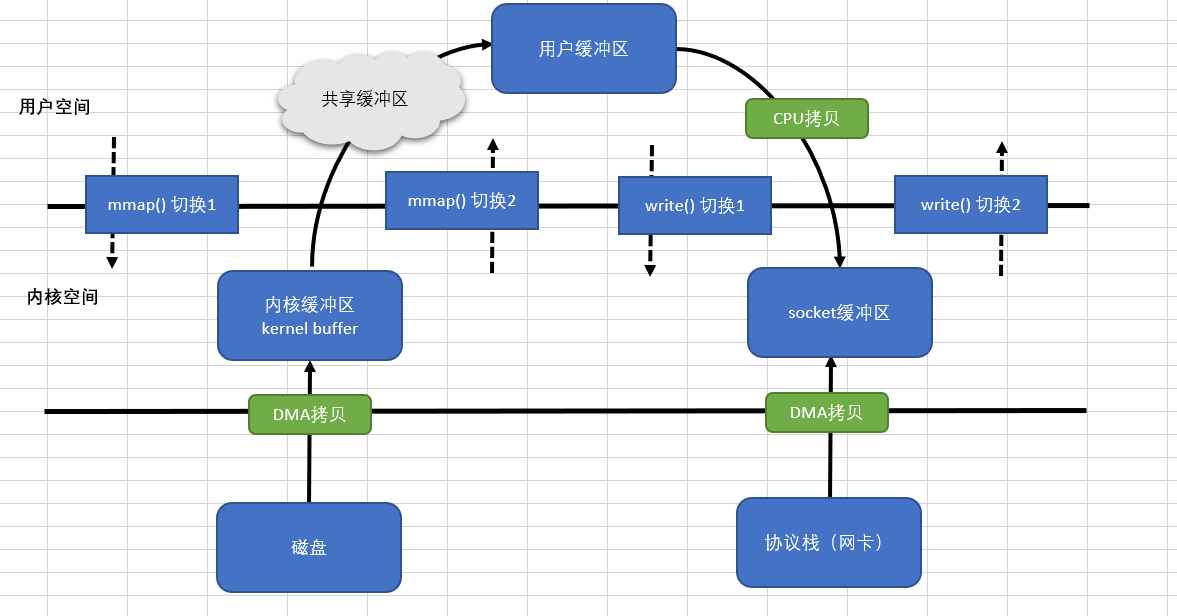
总的来说mmap减少了一次数据拷贝,总共4次上下文切换,3次数据拷贝
零拷贝之sendfile
Linux2.1 版本提供了 sendFile 函数,其基本原理如下:数据根本不经过用户态,直接从内核缓冲区进入到 SocketBuffer
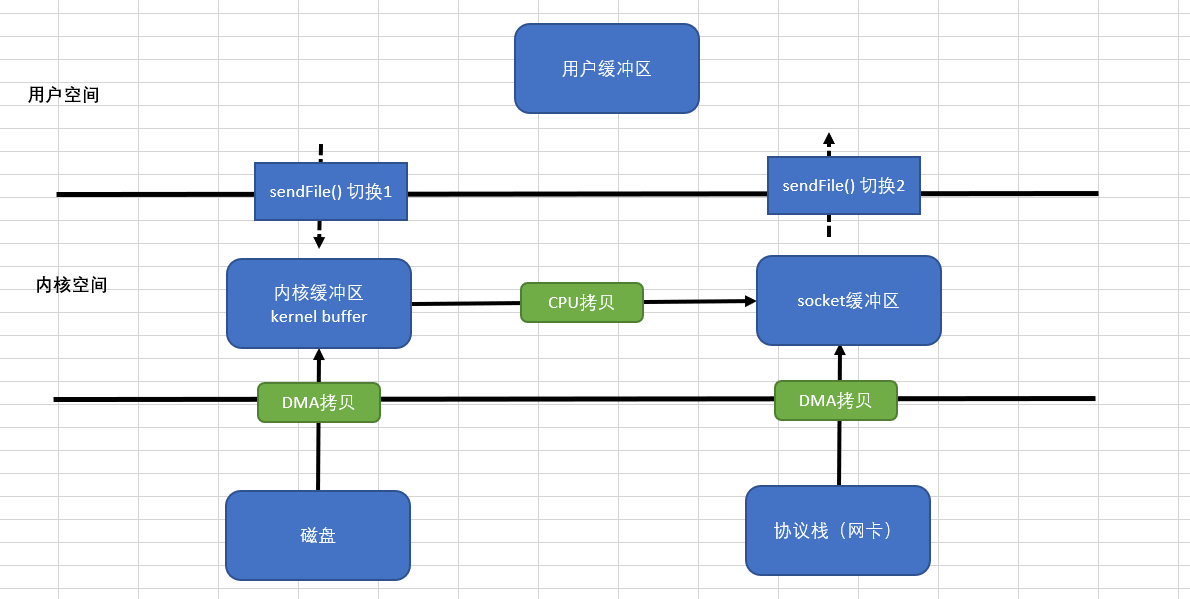
总的来说有2次上下文切换,3次数据拷贝。
sendfile再优化
Linux在2.4 版本中,做了一些修改,避免了从内核缓冲区拷贝到 Socketbuffer 的操作,直接拷贝到协议栈,从而再一次减少了数据拷贝
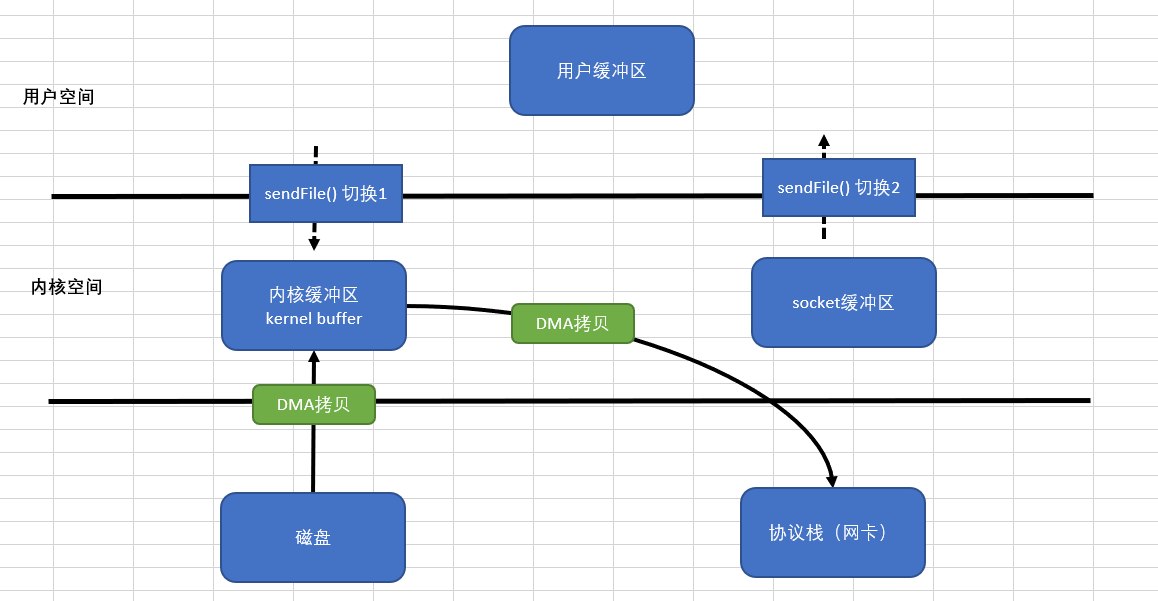
mmap 和 sendFile 的区别
(1)mmap 适合小数据量读写,sendFile 适合大文件传输。
(2)mmap 需要 4 次上下文切换,3 次数据拷贝;sendFile 需要 3 次上下文切换,最少 2 次数据拷贝。
(3)sendFile 可以利用 DMA 方式,减少 CPU 拷贝,mmap 则不能(必须从内核拷贝到 Socket缓冲区)。
NIO 零拷贝案例
案例要求:
- 使用传统的
IO 方法传递一个大文件
- 使用
NIO 零拷贝方式传递(transferTo)一个大文件
- 看看两种传递方式耗时时间分别是多少
传统拷贝方式
服务端:
1
2
3
4
5
6
7
8
9
10
11
12
13
14
15
16
17
18
19
20
21
22
23
24
25
26
27
28
29
30
31
32
33
34
35
36
37
38
39
40
41
42
43
44
| package com.fyp.nio.zerocopy;
import java.io.DataInputStream;
import java.io.IOException;
import java.net.ServerSocket;
import java.net.Socket;
public class OldIOServer {
public static void main(String[] args) throws IOException {
ServerSocket serverSocket = new ServerSocket(7001);
while (true) {
Socket socket = serverSocket.accept();
DataInputStream dataInputStream = new DataInputStream(socket.getInputStream());
try {
byte[] byteArray = new byte[4096];
while (true) {
int readCount = dataInputStream.read(byteArray, 0, byteArray.length);
if (-1 == readCount) {
break;
}
System.out.println("读取字节数: " + readCount);
}
} catch (Exception e) {
e.printStackTrace();
}
}
}
}
|
客户端:
1
2
3
4
5
6
7
8
9
10
11
12
13
14
15
16
17
18
19
20
21
22
23
24
25
26
27
28
29
30
31
32
33
34
35
36
37
38
39
40
41
42
43
44
45
| package com.fyp.nio.zerocopy;
import java.io.*;
import java.net.Socket;
public class OldIOClient {
public static void main(String[] args) throws IOException {
Socket socket = new Socket("localhost", 7001);
String fileName = "aiXcoder-3.3.1-2020.zip";
InputStream inputStream = new FileInputStream(fileName);
DataOutputStream dataOutputStream = new DataOutputStream(socket.getOutputStream());
byte[] buffer = new byte[4096];
long readCount;
long total = 0;
long startTime = System.currentTimeMillis();
while ((readCount = inputStream.read(buffer)) > 0) {
total += readCount;
dataOutputStream.write(buffer, 0 , (int) readCount);
}
System.out.println("发送总字节数: " + total + ", 耗时: " + (System.currentTimeMillis() - startTime));
dataOutputStream.close();
socket.close();
inputStream.close();
}
}
|
NIO拷贝方式
服务端:
1
2
3
4
5
6
7
8
9
10
11
12
13
14
15
16
17
18
19
20
21
22
23
24
25
26
27
28
29
30
31
32
33
34
35
36
37
38
39
40
41
42
43
44
45
46
47
48
49
50
51
| package com.fyp.nio.zerocopy;
import java.io.IOException;
import java.net.InetSocketAddress;
import java.net.ServerSocket;
import java.net.Socket;
import java.nio.ByteBuffer;
import java.nio.channels.ServerSocketChannel;
import java.nio.channels.SocketChannel;
public class NewIOServer {
public static void main(String[] args) throws IOException {
InetSocketAddress inetSocketAddress = new InetSocketAddress(7001);
ServerSocketChannel serverSockChannel = ServerSocketChannel.open();
ServerSocket serverSocket = serverSockChannel.socket();
serverSocket.bind(inetSocketAddress);
ByteBuffer buffer = ByteBuffer.allocate(4096);
while (true) {
SocketChannel socketChannel = serverSockChannel.accept();
int readCount = 0;
while (-1 != readCount) {
try {
readCount = socketChannel.read(buffer);
} catch (Exception e) {
break;
}
buffer.rewind();
}
}
}
}
|
客户端:
1
2
3
4
5
6
7
8
9
10
11
12
13
14
15
16
17
18
19
20
21
22
23
24
25
26
27
28
29
30
31
32
33
34
35
36
37
38
39
40
41
| package com.fyp.nio.zerocopy;
import java.io.FileInputStream;
import java.io.IOException;
import java.net.InetSocketAddress;
import java.net.Socket;
import java.nio.channels.FileChannel;
import java.nio.channels.SocketChannel;
public class NewIOClient {
public static void main(String[] args) throws IOException {
SocketChannel socketChannel = SocketChannel.open();
socketChannel.connect(new InetSocketAddress("localhost", 7001));
String filename = "aiXcoder-3.3.1-2020.zip";
FileChannel fileChannel = new FileInputStream(filename).getChannel();
long startTime = System.currentTimeMillis();
long transferCount = fileChannel.transferTo(0, fileChannel.size(), socketChannel);
System.out.println("发送总字节数: " + transferCount + ", 耗时: " + (System.currentTimeMillis() - startTime));
fileChannel.close();
}
}
|
三、Java AIO介绍
1. AIO基本介绍
JDK7 引入了 AsynchronousI/O,即 AIO。在进行 I/O 编程中,常用到两种模式:Reactor 和 Proactor。Java 的 NIO 就是 Reactor,当有事件触发时,服务器端得到通知,进行相应的处理AIO 即 NIO2.0,叫做异步不阻塞的 IO。AIO 引入异步通道的概念,采用了 Proactor 模式,简化了程序编写,有效的请求才启动线程,它的特点是先由操作系统完成后才通知服务端程序启动线程去处理,一般适用于连接数较多且连接时间较长的应用- 目前
AIO 还没有广泛应用,Netty 也是基于 NIO,而不是 AIO,因此我们就不详解 AIO 了,有兴趣的同学可以参考《Java新一代网络编程模型AIO原理及Linux系统AIO介绍》
2. BIO、NIO、AIO对比表
|
BIO |
NIO |
AIO |
| IO模型 |
同步阻塞 |
同步非阻塞(多路复用) |
异步非阻塞 |
| 编程难度 |
简单 |
复杂 |
复杂 |
| 可靠性 |
差 |
好 |
好 |
| 吞吐量 |
低 |
高 |
高 |
举例说明
- 同步阻塞:到理发店理发,就一直等理发师,直到轮到自己理发。
- 同步非阻塞:到理发店理发,发现前面有其它人理发,给理发师说下,先干其他事情,一会过来看是否轮到自己.
- 异步非阻塞:给理发师打电话,让理发师上门服务,自己干其它事情,理发师自己来家给你理发
漫画讲IO


























